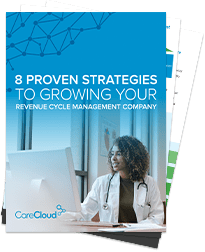Revenue cycle management (RCM) in healthcare affects your organization’s financial outcomes directly. With increasing administrative expenses and increased payer complexity, it is no longer a choice but a strategic requirement to learn how to improve RCM.
Here we can discuss 7 proven revenue cycle management (RCM) strategies to increase cash flow, lower denials, and enhance patient satisfaction. As a billing manager, practice administrator, or healthcare provider, implementing these RCM best practices can result in measurable improvement in operational effectiveness and financial well-being.
Understanding the Revenue Cycle Management Process
All administrative and clinical functions are included in healthcare RCM Process that contribute to the capture, management, and collection of patient service revenue. It generally consists of:
- Front-end RCM: Insurance verification, patient registration, prior authorizations.
- Mid-cycle: Clinical documentation, medical billing and coding efficiency, charge capture.
- Back-end RCM: Claims management, denial management, payment posting, patient collections process.
RCM in health care demands close integration between departments. One weak link, for example inaccurate insurance information or bad coding, can hold up payments and upset healthcare cash flow.
Key Strategies to Improve Revenue Cycle Management
1. Automate Key Processes across the Revenue Cycle
Revenue cycle automation particularly claims scrubbing, eligibility verification, and payment posting that reduces human error and accelerates turnaround. According to CareCloud, Practices employing automated RCM solution report up to 30% quicker claims processing and 25% fewer errors in high volume environments.
As reported by HFMA, automation of claim status checks alone can save providers as much as $11 per transaction.
2. Invest in Advanced RCM Technology and Analytics
A contemporary RCM solution provides real-time visibility into your revenue cycle performance, identifying bottlenecks such as slow payments or denials. Look for platforms that integrate with your practice management software and EHR for better RCM experience.
3. Enhance Front-End RCM for Clean Claims
Ensure real-time eligibility checks and accurate insurance capture at registration. CareCloud case study showed a 40% drop-in front-end rejections when front-desk staff were trained in payer-specific rules, and integrated verification tools were implemented.
4. Optimize Medical Coding and Documentation
Under-coded services leave money on the table. Over-coded claims present audit risk. Educating your employees in current ICD-10, CPT, and HCPCS codes and employing computer-assisted coding tools guarantees compliant, thorough claims.
Improved documentation also assists in revenue integrity in healthcare by ensuring that services are warranted and paid for.
5. Implement Denial Management Workflows
Denial management in healthcare continues to be one of the most expensive challenges in RCM. The solution to denial rate reduction lies in monitoring denial reasons, correcting root causes, and automating resubmission.
Example: A multi-specialty clinic cut denials by 42% within four months following the installation of a real-time denial monitoring dashboard and employee training.
6. Enhance Patient Collections and Payment Experience
The patient collection process has become more critical with growing out-of-pocket expenses. Providing online bill payment, payment arrangements, and pre-service estimates enhances collections and patient satisfaction. Ensure your RCM strategy covers patient financial counseling and clear communication regarding costs.
7. Track KPIs and Improve Continuously
Key performance indicators (KPIs) for healthcare revenue cycle optimization are:
- Days in A/R
- First-pass claim rate
- Denial rate
- Net collection rate
Use dashboards and analytics software to monitor these metrics, compare them against MGMA or HFMA benchmarks, and adjust your RCM strategies accordingly.
Best Practices for Optimizing Revenue Cycle Performance
Strategies differ by organization size and specialty, but these best practices for RCM are applicable across the board:
- Implement centralized RCM systems to break down silos between billing, coding, and front office.
- Regularly audit accuracy of coding and documentation.
- Quarterly train staff on payer policy updates and RCM tools.
- Use AI or machine learning to predict denial patterns and revenue risk.
- Outsource RCM if not enough internal resources are available, particularly for small practices.
Common Challenges in RCM and How to Solve Them
| Challenges | Solutions |
| High Denial Rates: As far as one can see, claim denials are the bane of healthcare RCM. Reasons could be everything from lack of documentation, coding errors, or eligibility issues. | To avoid these issues, practices must implement denial management tools that highlight problems to be fixed before submitting claims, track denial trends, and resubmit claims automatically after updating information. |
| Patient Non-Payment: As more patients assume payment for health care, collections present a significant cash-flow barrier. | With an emphasis on price transparency, this can be counteracted with point-of-service payment, setting up payment plan options, and electronic billing systems that are user-friendly. |
| Payer Delays: Delayed reimbursements from insurance payers to burden operations and affect financial planning. They are usually due to the lack of follow-up or paper-related problems. | It is possible to speed up the reimbursement by automating claim status inquiries, setting up escalation processes, and keeping payer rules up to date. |
| Staff Turnover and Training Gaps: Regular turnover of employees, especially in billing or coding roles, can cause consistency and quality of your RCM process. | Cross-training staff, workflow documentation, and ongoing education prevent disruptions and decreases the learning curve for new staff members. |
| Manual Errors and Disconnected Systems: Disconnected systems and manual data entry raise the potential for human error, duplicate work, and delayed billing. |
Transitioning to an integrated RCM solution that links front-end, mid-cycle, and back-end processes can automate processes and enhance overall accuracy. |
Benefits of Improving Revenue Cycle Management
1. Quicker Reimbursement and Improved Cash Flow
Streamlining your healthcare RCM process guarantees faster approval of claims and less payment delay. This directly enhances healthcare cash flow as well as makes your organization financially strong.
2. Lower Denial and Rejection Rates
Adopting smarter RCM strategies and automation eliminates the chances of errors resulting in claim denial. Fewer denial rates indicate less time spent on reworking claims as well as more revenues collected at the front end.
3. Increased Staff Efficiency and Productivity
Centralized RCM solution eliminates numerous tasks that can burden your billing and front-office teams, hence working effectively. This boost overall productivity and clashing burnout.
4. Enhanced Patient Financial Experience
A transparent billing process with accurate estimates and options to pay creates an easier process for the collection of debts from patients. This aims at a good financial experience for patients that increase satisfaction and loyalty.
5. Greater Revenue Integrity and Compliance
Accurate coding and documentation to sustain revenue integrity in healthcare. The two elements ensure that each audit risk is reduced and that any service is billed appropriately. These factors have long-term compliance and sustainability.
6. Data-Driven Financial Decision Making
Modern RCM solutions have good analytics to help track KPIs while projecting revenue trends. This allows leadership to make more strategic, data-informed decisions.
The Future of Healthcare RCM
With payer regulations increasing in complexity and patients assuming greater financial responsibility, the future of RCM in healthcare relies strongly on:
- Predictive analytics powered by AI
- Patient self-service portals
- End-to-end integrated platforms
- Value-based care financial models
Staying proactive with RCM strategies is important to achieve success in the healthcare marketplace. For long term viability, Invest in a scalable RCM solution today.
Conclusion
To do things in a smart way, it is important to learn how to improve RCM. By concentrating on automation, training, analytics, and patient-centric billing, thus turning a revenue cycle into a growth engine for your healthcare organization.
Frequently Asked Questions
Which is the most crucial aspect of a revenue cycle?
The most critical activities are front-end processes such as insurance verification and accurate patient data entry since these are the very first processes creating a basis for clean claims.
How can I bring down claims denial rates?
Use automated claims primary scrubbing; monitoring denial trends and staff on payer guidelines specific to help reduce claim denials.
What key performance indicator (KPI) should I monitor to be successful in RCM?
Days in A/R, denial rates, net collection rates, and clean claim rates have emerged as the core metrics.
Should I Outsource My Revenue Cycle Management RCM?
An outsourced, reliable provider of RCM solution can remarkably improve performance results for any practice with a shortage of internal resources or needing to ramp up faster.





